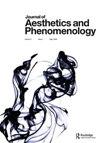Data as Expression
IF 0.2
0 PHILOSOPHY
引用次数: 0
Abstract
ABSTRACT In machine learning literature, the concept of expression is seldom addressed as a general term in relation to information construction and data. The term more often carries a narrower meaning and refers to human bodily, emotional, or artistic dimensions that are recorded to train a model. However, this paper discusses a view in which expression is understood as any human sensory realm that can bring incidents explicit through the act of “pressing out,” as the early etymology of expression indicates. Also, all the sensory data that are used to train a machine learning model and the data the trained model gives as an output are considered meaningful through their expressive mediality—a form that is actively produced and can therefore be subjected to critical phenomenological analysis. This paper contrasts nonverbal expressions with categorical or linguistic expressions and asks, “What do eye movements express when they are used in training a machine learning model? What kind of expression arises in linguistic models? What could be considered aesthetic data (and what would it express)?” For philosopher John Dewey, instinctive reactions in human behavior that for example exhibit mere discharge of an emotion should be separated from purposeful expressions. However, in machine learning, the two Deweyan positions (instinctive and intentional) collapse, as artificial expressions are purely simulations of learned logic. Therefore, the phenomenological question of this paper is traced back to the original stimulus and its human annotators. In this paper, philosopher Don Ihde’s experimental phenomenology explains how appearances can be attended to without subsuming them under any assumptions, whereas art theory—arising especially from philosopher Dieter Mersch’s thinking—provides an understanding of the mediality of expression. This paper introduces examples from machine learning that are not generally considered expressive but are used for regular tasks, such as object detection, and provides an alternative approach from aesthetics and artistic research that understands these modalities as expressive. If data are understood as expressive, it can be critically assessed how current machine learning models constitute knowledge.数据作为表达式
在机器学习文献中,表达的概念很少作为与信息构建和数据相关的一般术语来处理。这个术语通常具有更狭义的含义,指的是为了训练模型而记录的人类身体、情感或艺术方面的内容。然而,本文讨论了一种观点,即表达被理解为任何人类的感官领域,可以通过“挤出”的行为将事件明确地表达出来,正如表达的早期词源所表明的那样。此外,所有用于训练机器学习模型的感官数据和训练模型作为输出的数据都被认为是有意义的,因为它们的表达媒介是一种积极产生的形式,因此可以进行批判性的现象学分析。本文将非语言表达与分类或语言表达进行了对比,并提出了这样的问题:“当眼球运动用于训练机器学习模型时,它们表达了什么?语言模型中出现了什么样的表达?什么可以被认为是美学数据(它会表达什么)?”对于哲学家约翰·杜威来说,人类行为中的本能反应,例如仅仅表现出一种情感的释放,应该与有目的的表达分开。然而,在机器学习中,两种杜威言立场(本能和故意)崩溃了,因为人工表达纯粹是对学习逻辑的模拟。因此,本文的现象学问题可以追溯到原始刺激及其人类注释者。在本文中,哲学家Don Ihde的实验现象学解释了如何在没有任何假设的情况下关注表象,而艺术理论——尤其是来自哲学家Dieter Mersch的思想——提供了对表达的中介性的理解。本文介绍了机器学习中通常不被认为具有表现力但用于常规任务(如对象检测)的示例,并提供了一种来自美学和艺术研究的替代方法,将这些模式理解为具有表现力。如果数据被理解为具有表现力,则可以批判性地评估当前机器学习模型如何构成知识。
本文章由计算机程序翻译,如有差异,请以英文原文为准。
求助全文
约1分钟内获得全文
求助全文

 求助内容:
求助内容: 应助结果提醒方式:
应助结果提醒方式:


